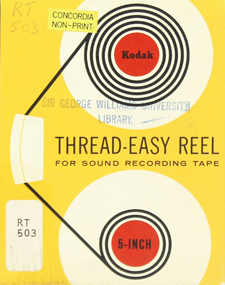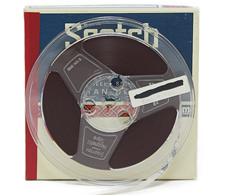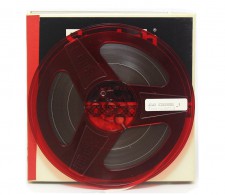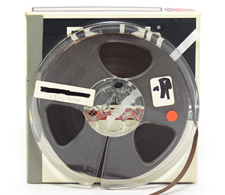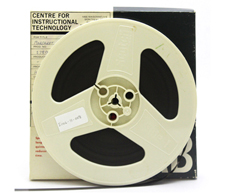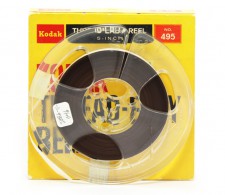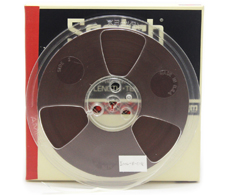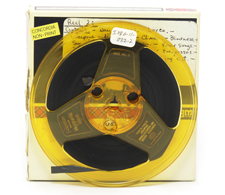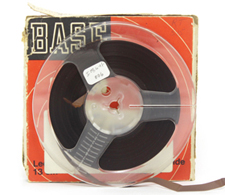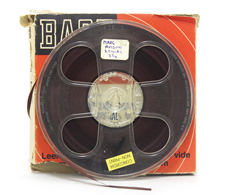As digital migration and networking broaden the territory, possibilities and forms of humanities scholarship, audio recordings of literary performances present a rich new area for critical inquiry. The poetry reading series, as a literary and performance genre and temporal entity, demands special emphasis as it resists straightforward classifications and modes of presentation. How can we approach, understand and engage with “the poetry series” as a discursive formation, a historical occasion, and as a literary subject as we encounter it through a variety of print and sound media artifacts? This special issue of Amodern interrogates the poetry series by orienting a range of critical, archival, historical and creative interventions around a single poetry series from the 1960s and 70s. That event, called “The Poetry Series,” was originally preserved on a collection of reel-to-reel tapes and has recently been digitally re-animated as SpokenWeb, a digital spoken word archive for literary research. Individual contributions to this issue are episodes in critical, historiographic and creative framing, a means of rendering the poetry series – an ephemeral program of events – discernible again in the present. Taken together, this issue of Amodern makes an argument for an expanded literary historical critical practice that considers the challenges of migrating literary cultural artifacts and media to digital formats, that registers the specificities of a distinctly audiotextual criticism, that confronts the benefits and risks of recognizing poetics as media poetics and literary histories as media and institutional histories, and that assembles new communities of scholarly practitioners in an effort to understand this manifestation of literary performance, including literary and cultural critics, digital humanists and designers, archivists, librarians, audience members, sound technicians and oral historians.
THESES ON DISCERNING THE READING SERIES
Jason Camlot, Darren Wershler
Theses on the literary reading series as a perceptible entity in the historical present, that: define it as an object of critical study, make claims for its significance within the discipline of literary studies, and identify the critical methodologies best used to make it discernible and material.
BEYOND THE TEXT
Literary Archives in the 21st Century
Al Filreis, Jason Camlot, Steve Evans
Between April 26-27, 2013, the Whitney Humanities Centre at Yale University brought together a group of literary and information science scholars, historians, curators, archivists, writers, and publishers for a two-day symposium in the Beinecke Library, where they listened to papers and panel discussions and engaged in intensive discussion about the status of the literary archive in the 21st Century. For the “Beyond the Text” symposium, Al Filreis (University of Pennsylvania), Jason Camlot (Concordia University), and Steve Evans (University of Maine) were invited to conduct a panel discussion that considered the literary Sound Archive. What follows is a textual translation of the original discussion.
MEDIA ARCHAEOLOGY OF POETRY AND SOUND
A Conversation with Shannon Mattern
Christine Mitchell, Shannon Mattern
Shannon Mattern’s broad-ranging media archaeological research and teaching attend to textual and literary spaces, sound archives and the materialities of media migration and transformation. This conversation alights on Mattern’s experience and insight and offers an indispensable entreé to the pleasures, risks, stakes and meanings of media historical investigation and hands-on archival work for literary and performance scholars confronting their objects of study as media artifacts. Addressing the practicalities and problems around archival research and archive building, Mattern charts the territory and signals key debates for newcomers to media archaeological ventures with respect to what sound and media archives mean, and the ways we encounter and create them.
NOTES ON PARAPHONOTEXTUALITY
Al Filreis
The live poetry reading can be understood as creating signifying moments of paratextuality – nontextual, extrapoetic aspects that serve to provide very specific interpretive cues to the listener as to how to respond to a poem at the moment of its utterance. From this emerges an aural literary history tracing a lineage of ways in which poets’ responses have in turn encouraged the alteration of the performance of the poem in mid-performance. At times such aural events change not just our sense but, too, the poet’s sense of the poem, even in its textual state. A study of phonoparatextual elements as they are left as traces in a recording can lead to a revised conception of the poetry reading as not like Erving Goffman’s notion of the lecture – for the performer’s antics are the poem, rather than the subject matter.
SETTING WIDESPREAD PRECEDENT
The Canada Council for the Arts and the Funding of Poetry Readings in Canada (1957–1977)
Cameron Anstee
This paper traces how the Canada Council for the Arts came to fund poetry readings beginning in 1959. It examines the tension between the experiment of funding readings and the centripetal impulses of the Council’s nationalist agenda. The specific material economic conditions that facilitated the widespread establishment of public readings as a common form of literary expression are documented, from the first grant of $845.00 in 1959 to the 136 grants totaling $190,430.00 issued in 1977. This provides historical grounding for a continued critical examination of the Canada Council and of conceptions of the “literary” in Canada that exist outside of traditional conceptions of the text.
AGAIN THE AIR CONDITIONERS
Finding Poetry in the Institutional Archive
Christine Mitchell
While the reel-to-reel tapes that preserved the SGWU Poetry Series can rightfully be considered literary artifacts, this paper explores their conditions of existence as instructional media productions. Archival research and interviews reveal that recording was overseen by a centralized campus media unit using equipment belonging to the university’s language laboratories and post-production routines oriented around materials for laboratory use. In examining the effects of media-pedagogical trends, staff routines, commitments, know-how and changing administrative priorities on the care and survival of the tapes at the micro level, the paper foregrounds a macro-level argument regarding the agency of institutions and their personnel in constructions and relations of mediality and literariness.
WE STOPPED AT NOTHING
Finding Nothing in the Avant-Garde Archive
Gregory Betts
Given its noticeably Western orientation, it is fair to characterize the SGWU reading series as the first re-presentation of the Vancouver literary community – or what George Bowering calls the “Vancouver Renaissance” in his introduction to Lionel Kearns in 1968 – in its full context (i.e. including many of its determining influences) outside of that locale. Though it would be years before critics narrativized the dissolution of the 60s avant-garde, one of the things that this re-presentation reveals is the bifurcation of aesthetics in the Vancouver avant-garde community. This paper explores the problem in the archivization of the series; for how does one represent or archive doubt, division, and conflict?
MISSION CONTROL
An Operator’s Manual for Compulibratories
Dean Irvine
Proposed here is a variation on Kenneth Goldsmith’s theorization of uncreative writing—a practice of uncreative reading, one that sees Early Birney’s experimentation with computer-assisted poetry as an act of human-machine interaction in which he reads digitally generated linguistic code through an analog process of critical perception and editing. One of Birney's computer-assisted poetry experiments (“Space Conquest”) is situated in relation to a genealogy of laboratory-based aesthetic research conducted by twentieth-century avant-garde writers, visual artists, and architects. Hypothesis: if uncreative writing is lab work—coding and decoding—uncreative reading is the execution of programs—both digital and analog—to parse linguistic, computational, and ideological codes.
SPOKEN, WORD
Audio-Textual Relations in UbuWeb, PennSound and SpokenWeb
Deanna Fong
This article proposes three models of audio-textual relations to illustrate varied responses to the problem of integrating sound and text in an online environment, each using a paradigmatic example as a case study. These models can be broadly termed modular (UbuWeb), situated (SpokenWeb) and constellatory (PennSound), to describe the projects’ organizational structure and aesthetic ethos. The article concludes with four suggested best practices for the design and functionality of digital audio archives that focus on how audio and text might ideally be integrated into a scholarly apparatus.
LIVE VINYL MP3
Mutant Sounds, PennSound, UbuWeb, SpokenWeb
Danny Snelson
This page follows a concentrated set of recordings across a range of digital platforms and media formats. As a test case, it tracks audio recordings made by bill bissett in the late sixties. Print artifacts are related to the recordings, which are, in turn, related to media platforms and distribution networks. These explorations stem from an inquiry into the situation of digital collections, little databases, and the processes of transcoding more generally. In this scenario, historical recordings are understood as facets of an internet archive that envelops the work from our present vantage. Additionally, this page features a concentrated set of expanded materials, including audio compilations, book snapshots, and a complete HTML archive of the music blog Mutant Sounds.
LISTEN! LISTEN! LISTEN!
Jackson Mac Low's Phonopoetics
Michael Nardone
Jackson Mac Low is well-known for his multimodal repertoire: poems that exist simultaneously as text, scores for performance, performance, and sound recordings. For all the attention Mac Low's critics give to the pluriform quality of his works, thereby including the stratum of sound, none write from a position of listening to them. This essay heeds Mac Low's primary admonition to the performers of his works – "Listen! Listen! Listen!" – in approaching the phonotext of his 1971 reading in Montreal. In doing so, I focus on how the actual sounds that Mac Low orchestrated in performance – and the many contexts these sounds intone and resonate through – allow for a more detailed understanding of the polyvalent systems of poetry he produced.
SOMEWHERE BLUEBIRDS FLY
Jackson Mac Low Directs a Poetry Reading
Brian Reed
This essay analyzes one evening of Jackson Mac Low’s avant-garde performance poetry, with special attention to the group piece “Bluebird Assymetries.” It argues that, although critics have tended to emphasize the empowering openness and freedom to be found in Mac Low’s work, one can in fact also observe a contrary impulse toward authorial and directorial control over the course and character of a performance’s unfolding. Instead of interpreting the interplay between the multiple voices in “Bluebird Assymetries” as modeling a utopian and anarchist form of sociality, one might better understand it by analogy to a different kind of community, ascetic and spiritual, in which one voluntarily submits to strict rules in the pursuit of sacred wisdom.
THE POEM AMONG US, BETWEEN US, THERE
Muriel Rukeyser’s Meta-Poetics and the Communal Soundscape
Jane Malcolm
This paper addresses the creation of imagined communal soundscapes and a poetics and politics of audience exchange in the archival recording of Muriel Rukeyser’s 1969 SGWU reading. Rukeyser’s prefatory question to her audience, “How many of you have ever written a poem?” and the inevitable silence that follows highlight the importance of negative space in the phonotext. If the lack of sound (or incomplete silence) is a prime feature of the sonic archive, we can read the archival recording itself as an imaginary/poetic text. What is unspoken and uncaptured thus points to a critical lacuna in the study of this archive (exemplified by Rukeyser’s unanswered question), as well as to the possibilities for sonic insurgency it signals.
PLAYING WITH TIME
Oral History and Literary Studies in the SpokenWeb Project
Ashley Clarkson, Steven High
Oral history and literary studies share an interest in the aural sense of the spoken word and the remembered event. The tone, volume and presentation of spoken word can fundamentally change the meaning of what is being said and bridge the gap between reader and audience. Our paper will consider the ways in which the SpokenWeb project has used sound recordings to emphasize the importance of close listening and in turn created deeply felt spaces of individual and generational life review and reciprocal sharing.
TRANSCRIPT COLLAGE
Things said at, and remembered about, poetry readings, c.1966/c.2014
Jason Camlot
Selected transcriptions of extra-poetic speech from The Poetry Series, 1966-1974, and SpokenWeb oral history interviews, 2012-2014.
THE POETRY SERIES?
Some Questions of Definition
Marjorie Perloff
In this response-essay, I suggest that the editors and contributors have done a superb job defining and analyzing the technology of the poetry series – its collection, organization, recording, digitization, archiving, and reception. At the same time, I argue that the aesthetic component of the poetry series has not received the same attention as has its production. I then distinguish between two groups of poets – the performers, who must be heard as well as read, and the “writerly” poets whose readings are ancillary to their texts rather than wholly integral. I also discuss the relation of individual to group readings and series, raising questions of value and poetic pleasure.




